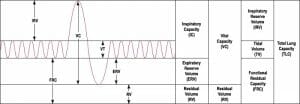Residual Volume Definition
Residual volume (RV) is the amount of air that remains in a person’s lungs after maximum exhalation. In other words, this is the volume of air that we can’t possibly get out of our lungs, meaning that the lungs are never completely empty of air. Otherwise, they would collapse as the tissue sticks together. On average, a person’s RV is about a liter and doctors can run special tests to find a person’s RV, as it can indicate lung health.
Below is a reading from a spirometer, a device used to measure the air capacity of lungs. The vertical axis indicates volume and the horizontal axis indicates time. As shown, the RV is the difference between the functional residual capacity, which is the amount of air left in the lungs after a natural exhalation, and the expiratory reserve volume, which is the maximum amount of air a person can still let out after natural exhalation.
Measuring the Residual Volume
Measuring the RV is not a straightforward process, so the following tests don’t give a direct answer but are instead techniques used indirectly to work out the RV.
Helium Dilution Test
In this test, the person has to inhale and exhales through a container that has a known amount of helium mixed with oxygen. The person inhales the mix and the final concentration of helium left in the container is used to calculate the RV.
Nitrogen Washout
100% oxygen is inhaled followed by an exhalation. The change in percentage of nitrogen (which people have in their lungs due to breathing normal air) from zero, in the inhaled air, to the amount that is exhaled is then used to estimate the RV.
Body Plethysmography
A plethysmography is usually used to measure changes in the volume of blood or air. The person has to sit in a closed chamber and breathe in and out of a mouthpiece that is then closed and the person has to exert effort trying to breathe in. The change in the pressure of the chamber due to change in size of the person’s chest walls is used to approximate the RV.
In other cases, when none of these techniques are used, estimations can be done by taking a particular proportion of the mass of infants or vital capacity, or based on height and weight.
The Effect of Disease on Residual Volume
Obstructive Lung Diseases
A person with an obstructive lung disease has a hard time exhaling the whole amount of air that an average person exhales. In this case, the RV is found to be higher than normal due to the excess air that remains trapped in the lungs after exhalation.
Restrictive Lung Diseases
In a restrictive lung disease, lungs can’t be expanded to the normal amount. What we find usually is a RV that is ordinary, because the flow of air in the airways is not hindered.
Related Terms
- Vital capacity – The volume of air that a person can forcibly exhale following maximum, forced inspiration.
- Minute ventilation – The volume of air that is breathed in and out within a minute.
- Inspiratory Capacity – The maximum amount of air that can be taken into the lungs following natural exhalation.
- Tidal volume – The amount of air that is inhaled an exhaled naturally and without force.
Quiz
1. Which of the following is true of obstructive lung diseases?
A. The residual volume is no different from normal
B. The diseases don’t allow for full expansion of the lungs
C. The residual volume is lower than normal
D. The residual volume is higher than normal
2. What is the average amount of residual volume in healthy lungs?
A. Two liters
B. One liter
C. Three liters
D. Six liters
3. Why is it that we can’t empty out our lungs?
A. Due to the amount of nitrogen contained in the air
B. Due to air pollution
C. The lungs would collapse and not be able to inflate again
D. Helium can’t leave the lungs

